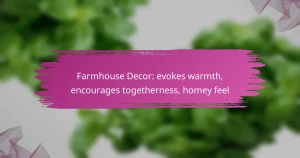Home decor encompasses a variety of styles that can transform a space into a personal sanctuary. In Canada, popular decor styles such as modern, rustic, bohemian, industrial, and minimalist each bring distinct aesthetics and functionalities to homes. Understanding your preferences and the characteristics of your space is essential for creating a cohesive and inviting atmosphere that reflects your unique taste.
Farmhouse Decor: evokes warmth, encourages togetherness, homey feel
Farmhouse decor is all about creating a warm and inviting atmosphere that encourages togetherness and comfort. By incorporating natural elements, warm colors, and vintage furnishings, you can transform your space…
Art Deco Decor: geometric patterns, luxurious materials, glamour
Art Deco decor embodies a captivating blend of geometric patterns, luxurious materials, and an unmistakable sense of glamour. Originating in the early 20th century, this style is celebrated for its…
Rustic Decor: natural materials, vintage accents, cozy atmosphere
Embracing rustic decor creates a warm and inviting atmosphere that celebrates natural materials and vintage accents. By incorporating elements like reclaimed wood, stone, and cozy textiles, you can evoke a…
Traditional Decor: creates nostalgia, enhances comfort, timeless feel
Traditional decor beautifully blends nostalgia with comfort, creating spaces that resonate with cherished memories and a sense of belonging. By incorporating familiar designs, materials, and colors, this style fosters an…
Rustic Decor: comforting atmosphere, encourages relaxation, warmth
Rustic decor brings a comforting atmosphere to any home, characterized by natural elements, warm colors, and vintage furnishings. By incorporating cozy textiles, soft lighting, and inviting seating, this style encourages…
Shabby Chic Decor: creates warmth, encourages comfort, vintage charm
Shabby Chic decor beautifully blends vintage charm with a cozy atmosphere, creating inviting spaces that encourage comfort and warmth. By incorporating soft colors, distressed finishes, and a mix of antique…
Farmhouse Decor: charming details, wood accents, country style
Farmhouse decor brings a touch of rustic charm to Canadian homes, emphasizing natural textures and vintage pieces that create a warm and inviting atmosphere. With a focus on wood accents…
Contemporary Decor: current trends, bold colors, innovative shapes
Contemporary decor is currently characterized by a striking fusion of minimalist and maximalist styles, showcasing bold colors and innovative shapes that reflect personal expression. Homeowners are increasingly opting for designs…
Modern Decor: sleek lines, minimalistic design, neutral colors
Modern decor transforms spaces by embracing sleek lines, minimalistic design, and a palette of neutral colors. This style prioritizes simplicity and functionality, creating serene environments that feel both inviting and…
Zen Decor: fosters peace, encourages mindfulness, serene environment
Zen decor is an artful approach to creating a peaceful and mindful living space that encourages relaxation and focus. By incorporating natural materials, soothing colors, and minimalist designs, you can…
What are the popular types of home decor in Canada?
In Canada, popular types of home decor reflect a blend of cultural influences and regional styles. Key decor styles include modern, rustic, bohemian, industrial, and minimalist, each offering unique aesthetics and functionalities for Canadian homes.
Modern decor
Modern decor emphasizes clean lines, minimalism, and a neutral color palette. This style often incorporates materials like glass, metal, and wood, creating a sleek and uncluttered look. To achieve modern decor, focus on functional furniture and open spaces that promote a sense of simplicity.
Consider adding statement pieces, such as abstract art or geometric furniture, to enhance the modern aesthetic. Avoid overcrowding spaces with excessive decor to maintain the style's characteristic openness.
Rustic decor
Rustic decor draws inspiration from nature, featuring raw materials and a cozy, warm atmosphere. Common elements include reclaimed wood, stone accents, and earthy color tones. This style is ideal for creating a welcoming environment that feels connected to the outdoors.
To incorporate rustic decor, use vintage or handmade items, such as wooden furniture or woven textiles. Balance the rustic elements with modern touches to prevent the space from feeling outdated or overly traditional.
Bohemian decor
Bohemian decor is characterized by its eclectic mix of colors, patterns, and textures, reflecting a carefree and artistic lifestyle. This style often includes vibrant textiles, layered rugs, and an assortment of decorative items from various cultures. It encourages personal expression and creativity.
To achieve a bohemian look, mix and match different styles and colors, and incorporate plants for a natural touch. Avoid overly matching items; the charm of bohemian decor lies in its curated randomness.
Industrial decor
Industrial decor takes cues from warehouses and factories, featuring raw materials like exposed brick, metal, and concrete. This style often includes open spaces and a neutral color palette, creating a rugged yet stylish atmosphere. It's popular in urban settings and loft-style homes.
To enhance industrial decor, incorporate vintage furniture and lighting fixtures, such as Edison bulbs. Keep the space uncluttered to highlight the structural elements, and consider using large, open shelving to display items without overwhelming the design.
Minimalist decor
Minimalist decor focuses on simplicity and functionality, stripping away excess to create a serene environment. This style uses a limited color palette, often featuring whites, blacks, and grays, with an emphasis on quality over quantity. It promotes a sense of calm and order.
To achieve a minimalist look, select essential furniture pieces and limit decorative items. Use hidden storage solutions to keep spaces tidy and avoid visual clutter. Remember, the goal is to create a peaceful and uncluttered living space.
How to choose the right home decor style?
Selecting the right home decor style involves understanding your personal preferences, the characteristics of your space, and how lighting affects the overall ambiance. By considering these factors, you can create a cohesive and inviting environment that reflects your taste.
Assess personal taste
Your personal taste is the foundation of your home decor style. Start by identifying what styles resonate with you, whether it's modern, rustic, eclectic, or traditional. Look for inspiration in magazines, online platforms, or even friends' homes to gather ideas that appeal to you.
Create a mood board with images, colors, and textures that you love. This visual representation can help clarify your preferences and guide your decor choices, ensuring that your home feels authentic to your style.
Consider space and layout
The size and layout of your space significantly influence your decor decisions. Measure your rooms to understand how much furniture and decor can fit comfortably without overcrowding. Open spaces may benefit from minimalistic designs, while smaller areas might require multifunctional furniture.
Think about the flow of movement within the space. Arrange furniture to facilitate easy navigation and create distinct areas for different activities, such as lounging or dining. This practical approach enhances both functionality and aesthetics.
Evaluate lighting conditions
Lighting plays a crucial role in home decor, affecting how colors and textures are perceived. Assess the natural light available in your space throughout the day. Rooms with ample sunlight can handle bolder colors, while darker areas may benefit from lighter shades to create a brighter atmosphere.
Incorporate various lighting sources, such as ambient, task, and accent lighting, to enhance the overall decor. Use lamps, overhead fixtures, and wall sconces to create layers of light that add warmth and depth to your home.
What are the key elements of modern home decor?
Modern home decor emphasizes simplicity, functionality, and a clean aesthetic. Key elements include sleek furniture, a neutral color palette, and open spaces that promote a sense of tranquility and spaciousness.
Sleek furniture
Sleek furniture is characterized by clean lines and minimal ornamentation, often made from materials like metal, glass, or polished wood. This type of furniture not only enhances the modern look but also maximizes functionality, often featuring multi-purpose designs.
When selecting sleek furniture, consider pieces that offer storage solutions without bulkiness, such as coffee tables with hidden compartments or modular sofas. Aim for a cohesive look by choosing furniture that complements the overall style of your space.
Neutral color palette
A neutral color palette forms the foundation of modern home decor, typically incorporating shades like white, beige, gray, and taupe. These colors create a calming environment and allow for flexibility in accenting with bolder hues through accessories and artwork.
To achieve a balanced look, use a mix of textures and materials within your neutral palette. For example, pair soft fabrics with smooth surfaces to add depth without overwhelming the space. Avoid overly bright colors that can disrupt the serene atmosphere.
Open spaces
Open spaces are essential in modern home decor, promoting a sense of freedom and flow throughout the home. This design approach often involves removing unnecessary walls and using furniture to define areas without creating barriers.
To enhance open spaces, consider using area rugs to delineate different zones, such as a living area or dining space. Keep furnishings minimal and avoid clutter to maintain the airy feel. Incorporating large windows or mirrors can further amplify the sense of openness by allowing natural light to flow through.
How does rustic decor differ from modern decor?
Rustic decor emphasizes natural elements and a cozy atmosphere, while modern decor focuses on minimalism and sleek lines. The key difference lies in the materials and aesthetic choices, with rustic styles often incorporating wood, stone, and earthy tones, contrasting with the clean, uncluttered look of modern design.
Natural materials
Rustic decor prominently features natural materials such as wood, stone, and metal. These elements create an organic feel, often sourced from local suppliers to enhance authenticity. For example, reclaimed wood furniture or stone accent walls can add character and warmth to a space.
In contrast, modern decor may utilize synthetic materials or polished finishes, which can lack the tactile quality found in rustic designs. When choosing materials, consider the environmental impact and sustainability of your selections.
Warm color schemes
Rustic decor typically employs warm color schemes, including earthy tones like browns, greens, and deep reds. These colors evoke a sense of comfort and connection to nature, making spaces feel inviting and homey. Accent pieces like throw pillows or rugs can enhance this warmth.
Modern decor, on the other hand, often favors cooler colors or monochromatic palettes, which can create a more sterile or impersonal atmosphere. When selecting colors for a rustic space, aim for hues that reflect the natural landscape around you.
Cozy furnishings
Cozy furnishings are a hallmark of rustic decor, featuring plush sofas, oversized chairs, and handmade textiles. These elements encourage relaxation and social interaction, often arranged to facilitate conversation. Consider incorporating vintage or handcrafted pieces to enhance the rustic charm.
In contrast, modern furnishings tend to prioritize form over comfort, often featuring sleek lines and minimal cushioning. While this can create a stylish look, it may sacrifice the inviting feel that rustic decor aims to achieve. When furnishing a rustic space, prioritize comfort and warmth in your choices.
What are the benefits of using eco-friendly decor?
Using eco-friendly decor offers numerous advantages, including improved health and a reduced environmental impact. These sustainable choices often lead to a healthier living space and contribute to the well-being of the planet.
Healthier living environment
Eco-friendly decor materials, such as natural fibers and non-toxic paints, help create a healthier living environment by reducing exposure to harmful chemicals. Many conventional decor items release volatile organic compounds (VOCs), which can negatively affect indoor air quality.
Choosing sustainable options can significantly lower these risks. For example, opting for low-VOC paints and finishes can improve air quality, making your home safer for all occupants, especially children and pets.
Additionally, eco-friendly materials often have better durability and longevity, reducing the need for frequent replacements. This not only saves money in the long run but also minimizes waste, further promoting a healthier planet.






